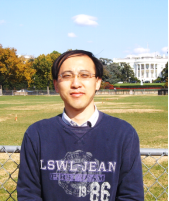王建颖
作者:发布时间:2024年03月27日 10:16点击数:627

姓 名:王建颖
职 称:副教授
出生日期:1980年9月
地 址:湖北大学材料科学与工程学院5027室
电子邮箱: wangjy_2002@163.com
一、学习及工作经历
1998.09-2002.07: 兰州大学,物理科学与技术学院,材料化学专业,理学学士学位
2002.07-2004.08: 中科院长春应用化学研究所,高分子工程实验室,研究实习员
2004.09-2007.03: 天津大学,理学院化学系,有机化学专业,理学硕士学位,
2007.03-2010.12: 中科院长春应用化学研究所,高分子化学与物理专业,理学博士学位,
2011.01-2013.02: 华中科技大学,化学与化工学院,博士后
2013.03-2014.03: 美国马里兰大学帕克分校,化学与生物化学系,访问学者
2014.07月-至今: 湖北大学,材料科学与工程学院,副教授,
2016年入选湖北省“楚天学者计划”楚天学子。
二、科研方向和科研成果
主要从事碳基量子点的合成及性能调控、光子晶体功能材料的设计制备、传感器、太阳能集光器、智能光伏窗户以及LED等方面的研究。在SCI收录的杂志上发表论文70余篇,包括:材料类国际顶级刊物Advanced Materials;Chemical Engineering Journal;Materials Horizon;ACS Appl. Mater. Interfaces; Journal of Materials Chemistry C; Polymer等。主持国家自然科学基金两项,湖北省自然科学基金三项,博士后基金两项,授权中国发明专利3件。
主要项目:
多重光子带隙荧光聚合物光子晶体薄膜的构建与性能,国家自然科学基金面上项目(51673060),62万,2017.1-2020.12。
碳基量子点的设计合成及其在太阳能集光器的应用研究,湖北省“楚天学者计划”项目,10 万,2017.1-2022.12。
3)光子晶体基染料敏化太阳能电池光阳极的制备及其电池光电转换性能研究(2015CFB266),湖北省自然科学基金面上项目,3万,2015.01-2016.12。
主要论著(#为共同第一作者;*为通讯作者)
X. C. Wang, J. Wu, D. Z. Huang, J. H. Yan, C. W. Li, Z. Q. Ren, J. H. Li, X. B. Wang, J. Y. Wang*. Constructing Highly Efficient and Ultra-stable (against Temperature, Humidity and Sunlight) Luminescent Solar Concentrators by Using Dendritic CsPbBr3@SiO2 Particles. Chem. Eng. J., 2024, 480, 148139.
C. Cai#, M. Z. Wang#, J. Y. Wang*, B. Xu, J. Wang, L. Zhang, W. Xin, L. J. Xue, J. H. Li, X. B. Wang. Efficiently Boosting the Optical Performances of Laminated Luminescent Solar Concentrators via Combing Blue-White Light-Emitting Carbon Dots and Green/Red Emitting Perovskite Quantum Dots. Appl. Surf. Sci., 2023, 609, 155313.
Z. P. Ren; J. Y. Wang*, C. L. Xue; M. H. Deng, H. Y. Yu, T. C. Lin, J. Y. Zheng, R. X. He, X. B. Wang, J. H. Li. Ultrahighly Sensitive and Selective Glutathione Sensor Based on Carbon Dot-Functionalized Solution-Gate Graphene Transistor. Anal. Chem., 2023, 95, 17750-17758.
W. Xin, J. Y. Wang*, B. Xu, J. Wu, J. Wang, Z. R. Ren, C. Cai, C. L. Xue, J. H. Li, X. B. Wang. Construction of Highly Efficient Carbon Dots-based Polymer Photonic Luminescent Solar Concentrators with Sandwich Structure. Nanotechnology 2022, 33, 305601.
J. Wu#, W. Xin#, Y. Wu, Y. Zhan, J. Li, J. Y. Wang*, S. Huang, X. B. Wang*, Solid-state photoluminescent silicone-carbon dots/dendrimer composites for highly efficient luminescent solar concentrators, Chemical Engineering Journal, 2021, 422, 130158.
J. Wang, J. Y. Wang*, Y. Xu, J. Jin, W. Xiao, D. Tan, J. H. Li*, T. Mei, L. J. Xue, and X. B. Wang*. Controlled Synthesis of Long-Wavelength Multicolor-Emitting Carbon Dots for Highly Efficient Tandem Luminescent Solar Concentrators. ACS Appl. Energy Mater. 2020, 3, 12230-12237.
Q. Fan, J. H. Li*, Y. Zhu, Z. Yang, T. Shen, Y. Guo, L. Wang, T. Mei, J. Y. Wang*, X. B. Wang. Functional Carbon Quantum Dots for Highly Sensitive Graphene Transistors for Cu2+ Ion Detection. ACS Appl. Mater. Interfaces 2020, 12, 4797-4803.
4) L. Wang*, J. Y. Wang*. Self-Assembly of Colloids Based on Microfluidics. Nanoscale 2019, 11, 16708-16722.
5) Y. H. Zhu, J. Y. Wang*, X. Zhu, J. Wang, L. Zhou, J. Li, T. Mei, J. Qian, L. Wei, X. B. Wang*. Carbon Dot-Based Inverse Opal Hydrogels with Photoluminescence: Dual-mode Sensing of Solvents and Metal Ions. Analyst 2019, 144, 5802-5809.
6) J. Y. Wang*, Y. H. Zhu, L. Wang*, Synthesis and Applications of Red-emissive Carbon Dots, Chem. Rec., 2019, 19, 2083-2094.
7) X. Zhu, J. Y. Wang*, Y. Zhu, H. Jiang*, D. Tan, Z. Q. Xu, T. Mei, J. H. Li, L. J. Xue, X. B. Wang*. Green Emitting N,S-co-Doped Carbon Dots for Sensitive Fluorometric Determination of Fe(III) and Ag(I) ions, and as a Solvatochromic Probe. Microchim Acta, 2018, 185, 510.
8) X. L. Jia, T. Zhang, J. Y. Wang, K. Wang, H. Y. Tan, Y. D. Hu, L. B. Zhang, J. T. Zhu*. Responsive Photonic Hydrogel-Based Colorimetric Sensors for Detection of Aldehydes in Aqueous Solution. Langmuir 2018, 34, 3987-3992.
9) J. Y. Wang#, K. Song#, L. Wang, Y. J. Liu, B. Liu, J. T. Zhu*, X. L. Xie, Z. H. Nie*. Formation of Hybrid Core-Shell Microgels Induced by Autonomous Unidirectional Migration of Nanoparticles. Mater. Horiz., 2016, 3, 78-82.
10) L. Wang#, J. Y. Wang#, K. Song*, W. L. Li, Z. Q. Huang, J. T. Zhu, X. J. Han*, Z. H. Nie*. Light-triggered Generation of Multifunctional Gas-filled Capsules On-Demand. J. Mater. Chem. C., 2016, 4, 652-658.
11) X. L. Jia, J. Y. Wang, K. Wang, J. T. Zhu*. Highly Sensitive Mechanochromic Photonic Hydrogels with Fast Reversibility and Mechanical Stability. Langmuir 2015, 31, 8732-8737.
12) X. L. Jia, Y. D. Hu, K. Wang, R. J. Liang, J. Y. Li, J. Y. Wang*, J. T. Zhu*. Uniform Core-Shell Photonic Crystal Microbeads as Microcarriers for Optical Encoding. Langmuir 2014, 30, 11883-11889.
13) J. Y. Wang, W. K. Li, J. T. Zhu*. Encapsulation of Inorganic Nanoparticles into Block Copolymer Micellar Aggregates: Strategies and Precise Localization of Nanoparticles. Polymer 2014, 55, 1079-1096.
14) J. Y. Wang, Y. D. Hu, R. H. Deng, R. J. Liang, W. K. Li, S. Q. Liu, J. T. Zhu*. Multiresponsive Hydrogel Photonic Crystal Microparticles with Inverse-Opal Structure. Langmuir 2013, 29, 8825-8834.
15) J. Y. Wang, J. T. Zhu*. Recent Advances in Spherical Photonic Crystals: Generation and Applications in Optics. Eur Polym J, 2013, 49, 3420-3433.
16) Y. D. Hu, J. Y. Wang, C. N. Li, Q. Wang, H. Wang, J. T. Zhu*, Y. J. Yang*. Janus Photonic Crystal Microspheres: Centrifugation-Assisted Generation and Reversible Optical Property. Langmuir 2013, 29, 15529-15534.
17) J. Y. Wang, Y. D. Hu, R. H. Deng, W. J. Xu, S. Q. Liu, R. J. Liang, Z. H. Nie, J. T. Zhu*. Construction of Multifunctional Photonic Crystal Microcapsules with Tunable Shell Structures by Combining Microfluidic and Controlled Photopolymerization. Lab Chip, 2012, 12, 2795-2798.
18) J. Y. Wang, Y. C. Han*. Tuning the Stop Bands of Inverse Opal Hydrogels with Double Network Structure by Controlling the Solvent and pH. J. Colloid Interface Sci., 2011, 353, 498-505.
19) J. Y. Wang, Y. C. Han*. Tunable Multicolor Pattern and Stop-Band Shift Based on Inverse Opal Hydrogel Heterostructure. J. Colloid Interface Sci., 2011, 357,139-146.
20) J. Y. Wang, Y. C. Han*. Tunable Multi-Responsive Methacrylic Acid Based Inverse Opal Hydrogels by Controlling the Synthesis Conditions. Langmuir 2009, 25, 1855-1864.
21) J. Y. Wang, Y. Cao, Y. Feng, F. Yin, J. P. Gao*. Multiresponsive Inverse-Opal Hydrogels. Adv. Mater., 2007, 19, 3865-3871.
